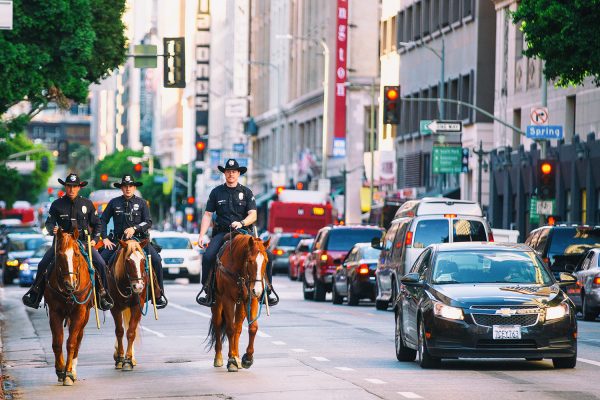
It’s exasperating to see yet another black man shot by police in America when he posed no apparent threat. Officers fired seven bullets into the back of Jacob Blake in Kenosha, Wisconsin, when he leaned into his car.
Blake survived. George Floyd didn’t. He suffocated when a white police officer, Derek Chauvin, sat on his neck for almost 9 minutes in Minneapolis in May.
Floyd’s death triggered nationwide protests. Blake’s shooting provoked demonstrations as well as looting and riots in Kenosha.
Black men in America are two-and-a-half times more likely to be killed by police than white men. African Americans comprise 12 percent of the population but 33 percent of prisoners. Black men are routinely arrested and prosecuted for misdemeanors and victimless crimes when whites aren’t.
So it’s not hard to understand why “defund the police” has become a popular slogan.
But it’s not a solution.
Reforms
In the wake of Floyd’s death, I proposed several reforms to improve policing in America.
Some wouldn’t cost anything:
- Ban assault rifles, stun grenades and tear gas from crowd and riot control.
- Ban chokeholds and strangleholds (which killed Floyd).
- Break down the “blue wall of silence” that prevents police officers from reporting on each other. Require officers to intervene if a colleague uses excessive force. Require officers to report all uses of force. Reprimand those who don’t.
- Make it easier to investigate officers. Stop erasing records of misconduct.
Others would be expensive:
- Demilitarize the police. The military could no longer sell surplus armored personnel carriers, body armor and rifles to police departments.
- Institute community policing, with officers who live in the communities they serve.
- Instruct and train officers to deescalate first and use force as a last resort. Require a warning before shooting. Restrict shooting at moving vehicles.
- Fund nonprofits and social services that help to reduce crime.
Police killings
Black men are most likely to be the victims of police violence, but American police are exceptionally violent in general.
American police officers are three times more likely to kill than their Canadian counterparts and many times more likely than their European colleagues.
Police kill about 1,700 Americans per year, making them responsible for one in twelve violent deaths. Between 2010 and 2018, more Americans were killed by police (around 14,400) than on active military duty (9,400).
Nearly one in two victims of police shootings are mentally ill or under the influence of drugs.
American police officers themselves are more likely to be killed than their rich-world counterparts, owing to the proliferation of firearms in civilian hands.
But crime and police deaths have come down while police killings have gone up.
Training
Inadequate training is one reason American police officers are so quick to draw their guns.
It takes just 21 weeks of classroom training, plus twelve weeks of field training, to become a police officer in the United States.
Similar European programs can last more than three years.
What little training American police receive is still informed by the era of high crime. Police spend the vast majority of their time on crowd control, domestic disputes, false burglary and false fire alarms, traffic incidents and vandalism, and just 4 percent of their time on violent crimes. Yet it’s violent crime they train for.
Recruits spend 168 of their 840 hours of training on self-defense and the use of force, 42 hours on criminal investigations and 38 hours on operating an emergency vehicle. Just 10 hours are set aside to teach aspiring cops about mental illness and 9 hours are devoted to conflict management and mediation.
Spending
Police spending per capita has nearly doubled in the United States in the last 25 years, when per-capita homicides fell by a third.
America spends about 1 percent of its GDP on police, which puts it in the middle tier of democratic countries. The Scandinavians spend relatively less and are safer. France, Spain and the United Kingdom spend relatively more and are safer.
So the issue is not spending per se, but how the money is spent.
Roughly two-thirds of police spending is for payroll.
The average police salary in the OECD is $64,800, or 1.5 times GDP per capita. Australia, Canada and Western European countries pay their police officers more and have lower crime. Central and Eastern European countries pay their officers less and have higher crime.
Those countries also spend less on access to health care, including mental health, and social services, which are known to reduce crime.
The average police salary in the United States is $67,600, which is more than the national average of $53,490. But there are huge disparities between states.
California, Illinois and New York pay their officers significantly more: as much as $105,220 per year. Mississippi pays half the national average.
Nine of the ten highest-paying states are governed by Democrats. (The exception is Alaska.) The ten lowest-paying states are governed by Republicans. Those are also among the most violent.
The correlation between police spending and safety is imprecise, but the countries and states that undertrain and underpay their police, and spend more on repression than prevention, tend to have more police violence and higher crime. Those that train and pay their police well, and adequately fund (mental) health and social services, tend to have lower police violence and lower crime.
